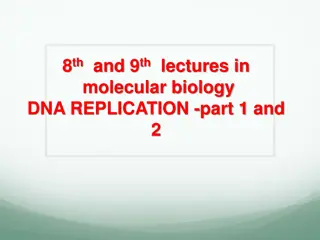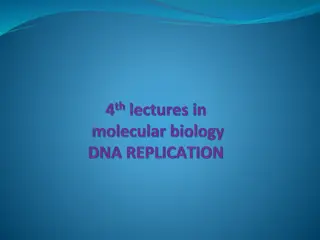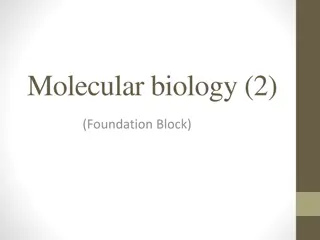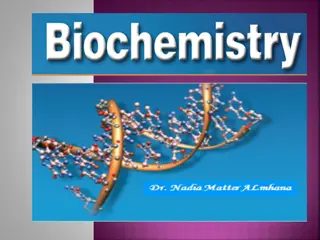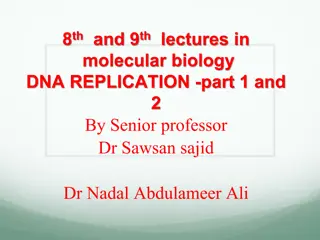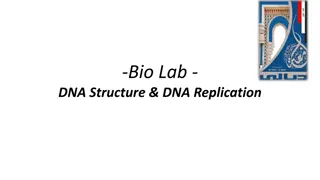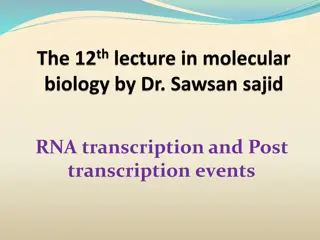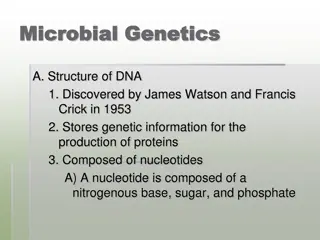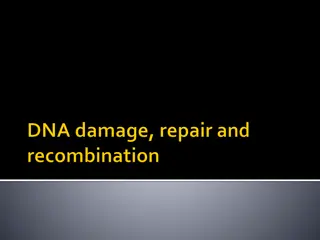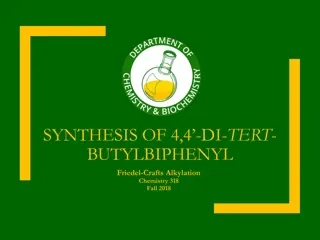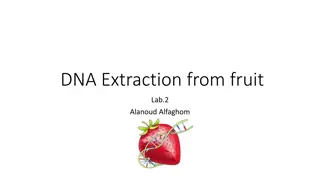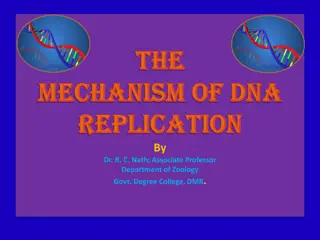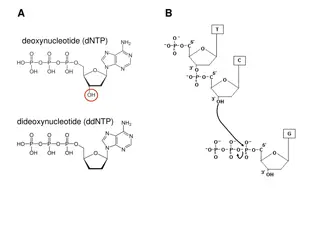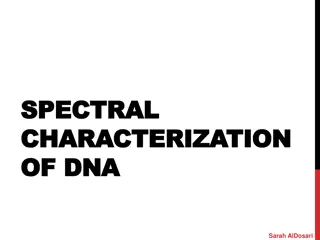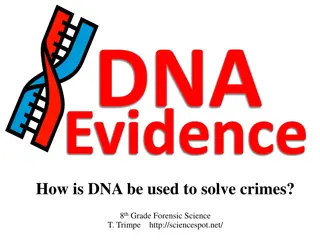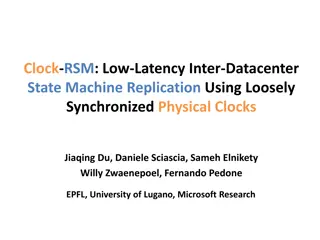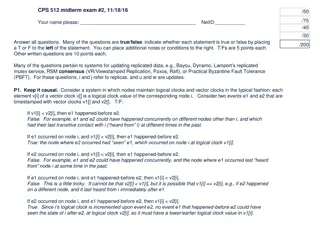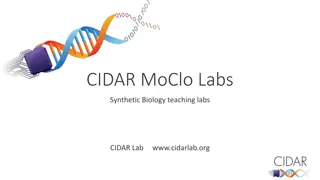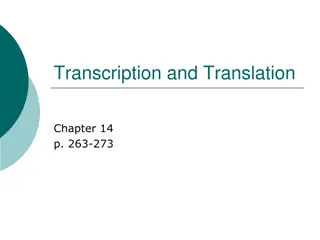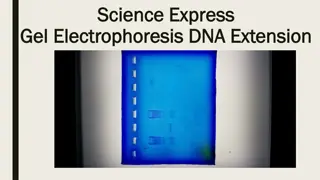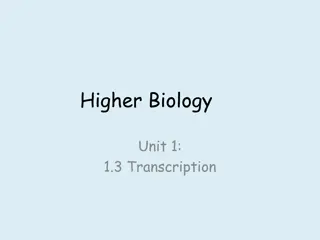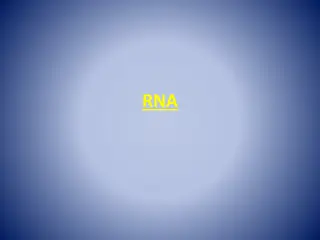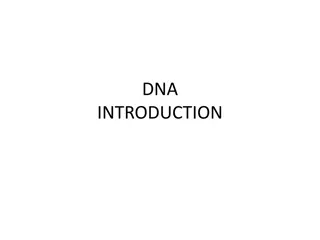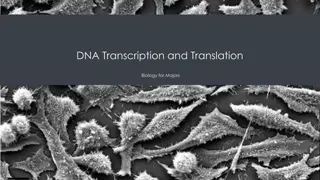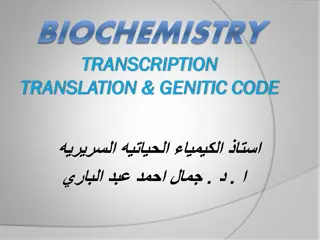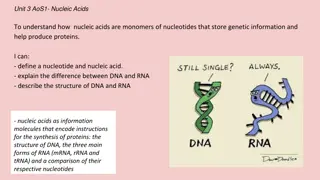Understanding DNA Replication: From Basics to Lab Synthesis
DNA replication is a fundamental process in all living organisms, essential for biological inheritance. This comprehensive guide explores the stages of DNA replication, highlighting key experiments and differences between prokaryotic and eukaryotic replication. Additionally, it delves into the revolutionary technique of DNA synthesis in the laboratory using PCR, detailing the necessary components and procedures involved.
Download Presentation

Please find below an Image/Link to download the presentation.
The content on the website is provided AS IS for your information and personal use only. It may not be sold, licensed, or shared on other websites without obtaining consent from the author. Download presentation by click this link. If you encounter any issues during the download, it is possible that the publisher has removed the file from their server.
E N D
Presentation Transcript
DNA replication is the process of producing two identical copies from one original DNA molecule. This biological process occurs in all living organisms . It is the basis for biological inheritance. DNA is composed from strands and each strand of the original DNA molecule serves as template for the production of the complementary strand, a process referred to as semiconservative replication and the process followed by proofreading mechanisms to ensure correct reading to the genetic code,. like all biological polymerization processes(Transcription and Translation), the process involve 3 stages : 1- initiation 2-elongation and 3- termination. Early studies of DNA replication mainly depend on the observation of Meselson and Stahl(1958) biochemist John Carnis (1963) and the Japanese scientist Reiji Okazaki (1968) two or error-checking ,the British
Prokaryotic and eukaryotic DNA replication is bidirectional The experiment of John Cairns in 1963 demonstrated by autoradiography that the DNA of Escherichia coli is a single circular not linear molecule that is replicated from a point or moving locus forming the ( replicating fork) at which both new DNA strands are being synthesized. The movement of this fork is bidirectional in another world there are two moving forks, traveling in opposite directions around the chromosome forming theta shape (the Greek letter) which look like a bubble . it start from one point called ori c (origin of replication) and replication continue till reaching the opposite direction in one point called Ter I ( from terminus). Also the shape is called the (A-butter fly replication) ( )
Replication in eukaryotic cell start from more than one ori c(each 300bp there is oric ) so multiple replication bubbles will form thus replication here is faster than prokaryotic cell
DNA COULD BE SYNTHESISED IN LAB The dream become true for synthesizing part of the genome in lab after 3 decade from discovering DNA polymerase enzyme precisely in 1983 by Kary mullis who found a genius way to amplify ( ) any part of the genomic DNA by PCR process (polymerase chain reaction)the process require the following: Template DNA (genomic animal or plant cell , plasmid, cosmid, bacterial/yeast colony, etc.) primers :usually forward and reverse DNA primers(17-25bp) forwarded from 5 OH 3 with free end thus DNA polymerase will use this end to add nucleotide to the newly formed strand .in nature this segment is synthesized by primase enzyme (RNA rather than DNA as will discussed latter) buffer for DNA polymerase enzyme To enhance enzyme activity we add MgCl2or MgSO4. dNTPs :The four type is used (dATP, d TTP, d GTP, d CTP) . Taq DNA polymerase: heat stable enzyme is used here . Cos of its stability in heat during denarturation step (95C )
Polymerase chain reaction Polymerase chain reaction Researchers commonly the polymerase chain reaction (PCR). PCR uses a pair of primers to span a target region in template DNA, and then polymerizes partner strands in each direction from these primers using a thermostable Taq DNA polymerase. Repeating this process through multiple cycles produces amplification of the targeted DNA region. At the start of each cycle, the mixture of template and primers is heated, separating the newly synthesized molecule and template. Then, as the mixture cools, both of these become templates for annealing of new primers, and the polymerase extends from these. As a result, the number of copies of the target region doubles each round, increasing exponentially replicate DNA in vitro using
Properties of Taq DNA polymerase Taq polymerase the thermophilic bacterium Thermus aquaticus from which it was originally isolated by Thomas D. Brock. It is often abbreviated to "Taq Pol" and is frequently used in polymerase chain reaction(PCR), a method for greatly amplifying short segments of DNA . T. aquaticus is a bacterium that lives in hot springs and hydrothermal vents, and Taq polymerase was identified as an enzyme able to withstand the protein-denaturing conditions (high temperature) required during PCR. Therefore it replaced the DNA polymerase from E. coli originally used in PCR. Taq's optimum temperature for activity is 75 80 C, with a half-life of greater than 2 hours at 92.5 C , and can replicate a 1000 base pair strand of DNA in less than 10 seconds at 72 C. One of Taq's drawbacks fidelity It lacks a 3' to 5' exonuclease proofreading activity, and has an error rate measured at about 1 in 9,000 nucleotides. thermostable DNA polymerases have been isolated from other thermophilic bacteria and archaea, such as polymerase, possessing a proofreading activity, and are being used instead of (or in combination with) Taq for high-fidelity amplification. is a thermostable DNA polymerase named after is its relatively low replication Some vent and Pfu DNA
DNA Helicase Also known as helix destabilizing enzyme cases formation of Replication Fork due to broken hydrogen bonds DNA Polymerase Builds a new duplex DNA strand by adding nucleotides in the 5' to 3' direction. performs proof-reading and error correction. DNA clamp: A protein (unit from polymerase which prevents DNA polymerase III from dissociating from the DNA parent strand. Single-Strand Binding (SSB) Proteins Bind to ssDNA and prevent the DNA double helix from re-annealing after DNA helicase unwinds it thus maintaining the strand separation DNA Gyrase (and Topoisomerase IV) ; this is a specific type of topisomerase II convert relaxed form to super coiled DNA Ligase Re-anneals the semi-conservative strands and joins Okazak i Fragments of the lagging strand. Primase Provides a starting point for DNA polymerase to begin synthesis of the new DNA strand. Topoisomerase I : Relaxes the DNA from its super-coiled nature Telomerase Lengthens telomeric DNA by adding repetitive nucleotide sequences to the ends of eukaryotic chromosomes
Some important and basic information Primase: in fact is RNA polymerase thus the formed primer is RNA rather than DNA and it will removed latter by DNA polymerase I Topoisomerase I: will break the 3 converting super coiled to relax form which opposite to ligase Helicase : will break hydrogen bond between the two strand Movement of replication fork 5 3 which is the same direction of polymerization and direction of Leading strand ( While the direction of lagging strand( Polymerization in leading strand is continuously but it is un continuously in lagging strand thus okazaki fragment will form Okazaki fragments are 2,000 nucleotides long in Escherichia coli and are between 100 and 200 nucleotides long in eukaryotes. They are separated by ~10-nucleotide RNA primers and are un ligated until RNA primers are removed, followed by enzyme ligase connecting (ligating) the two Okazaki fragments into one continuous newly synthesized complementary strand 5 phosphodiester bond ) is 3 5 ) between 1,000 and
Types of DNA polymerase in Prokaryotic cell Initiation activity Polymerization 5 3 Exonuclease activity 3 5 Exonuclease activity 5 3 Types of enzyme DNA polymerase I + + + - DNA polymerase II + + - - DNA polymerase III + + - -
Types of DNA polymerase in Eukaryotic cell The understood Eukaryotic cells polymerases: mitochondria, although it is encoded by a nuclear gene. Plant chloroplasts also contain their own DNA polymerase that appears to be similar to Pol polymerase: it is the only enzyme has primase activity beside DNA polymerase so it is self- primed it will form short primer 12-20 nts called the initiator RNA iRNA) Pol polymerase: excision repair and it is not highly active and is not very processive. Pol polymerase: polymerization the mitochondrial DNA beside repairing by its exonuclease activity 3 5 Pol and polymerase :polymerization lagging ( )and leading ( ) strand respectively 5 3 . In eukaryotes, the low-processivity initiating enzyme, Pol , has intrinsic primase activity. The high- processivity extension enzymes are Pol and Pol . DNA polymerases than of DNA at least eukaryotes polymerases five , , are in of general prokaryotes, nuclear is found in less the have , , major DNA .
Differences between leading and lagging strand replication
A new DNA strand is always synthesized in a 5 to 3 manner, thus the replication of both the strands goes in two differentways. 1- Leading strand A leading strand is the strand which is run from 5 -3 direction or the direction the same as the replication fork movement. It is synthesized continuously; there are no breaks in-between. This strand is formed as nucleotides are continuously added to the 3 end of the strand after polymerase reads the original DNA template . Only one primer will require here .no Okazaki fragment will formed. 2 DNA polymerase molecules are required for polymerization the two strands which run together in the same machine binding together but still the replication happened in opposite direction The polymerase involved in leading strand synthesis is DNA polymerase III(DNA Pol III) in prokaryotes and presumably Pol in yeasts. In human cells the leading and lagging strands are synthesized by Pol and Pol , respectively, within the nucleus and Pol in the mitochondria.[ .
2- lagging strand: A lagging strand is the strand which is synthesized in the 3 - 5 direction or opposite direction as to the movement of the replication fork. It grows or is synthesized away from the fork. Its movement in the opposite direction is the cause why it is discontinuous; it is synthesized in fragments. The primase, which is responsible for adding an RNA primer, has to wait for the fork to open before putting the primer. The lagging strands have fragments of DNA which are called Okazaki fragments. More than one primer will be necessary here and it will be removed latter by the exonuclease activity of DNA polymerase (I) which will fill the gap between two adjacent Okazaki fragments .the final binding will done by the activity of ligase enzyme who will add a 3 5 phospho diester bond continuously ; this is the reason why the synthesis of the lagging strand is more complicated than the leading strand. .
The DNA replication machinery The Replisome is composed of the following: 2 DNA Pol III enzymes molecules , each has a core subunits composed from 3 sub units , and subunits. the subunit has the polymerase activity. the subunit has 3' 5' exonuclease activity. the subunit stimulates the subunit's proofreading. 2 units which act as sliding clamps( bound to the DNA template . 2 units which acts to dimerism two of the core enzymes ( , , and subunits). Thegamma complex which acts as a clamp loader ( for the lagging strand helping the two subunits to form one unit and bind to DNA. The unit is made up of 5 subunits which include 3 subunits, 1 subunit , and 1 ' subunit . The is involved in copying of the lagging strand. Beside that there are and which complete the complex and bind to DNA polymerase III synthesizes base pairs at a rate of around 1000 nucleotides per second. DNA Pol III activity begins after strand separation at the origin of replication. Because DNA synthesis cannot start replication , an RNA primer, complementary to part of the single-stranded by primase (an RNA polymerase) (keeping the polymerase ) DNA, is synthesized
Structure and sub units of 2 DNA polymerase III(replisome)
Steps of DNA replication 1- Initiation: the process require replictor and intiator protein(DnaA protein ). For a cell to divide, it must first replicate its DNA.This process is initiated at particular points in the DNA, known as replicator (200-300 bp) specific area called "origin of replication ori c or Dna A box) ", which will opened by initiator proteins. In E. coli this protein is called DnaA protein ; in yeast, is called complex. Sequences opened by initiator proteins tend to be "AT- rich" (rich in adenine and thymine bases), because A-T base pairs have two hydrogen bonds (rather than the three bond in a C-G pair). Once the origin has been recognized proteins (DnaA protein )start complex, which unwind the double-stranded DNA .All known DNA replication systems require a free 3' hydroxyl group before synthesis can be initiated (RNApolymerase) to synthesize a short RNA primer(10-20 bp) with a free 3 OH group which is subsequently elongated by a DNA polymerase in this mechanism, In eukaryotes, primase is produce by Pol DNA polymerase and Pol /Pol are responsible for extension of the primed segments which contain origin recognition ,the initiators the pre-replication forming . use a primase enzyme
Replication fork The replication fork is a structure that forms during DNA replication .Many enzymes are involved in the DNA replication fork in order to stabilize initiation step . helicases, which break the hydrogen bonds holding the two DNA strands together. The resulting structure has two branching "prongs", each one made up of a single strand of DNA. These two strands serve as the template for the leading and lagging strands, which will be created as DNA polymerase matches complementary nucleotides to the templates; the templates may be properly referred to as the leading strand template and the lagging strand templates. SSBPs also required here 2- Elongation step DNA is always synthesized in the 5' to 3' direction. Since the leading and lagging strand templates are oriented in opposite directions at the replication fork, a major issue is how to achieve synthesis of nascent (new) lagging strand DNA, whose direction of synthesis is opposite to the direction of the growing replication fork. :
1-The leading strand receives one RNA primer while the lagging strand receives several 2- The leading strand is continuously extended from the primer by a high processivity ( , polymerase, while the lagging discontinuously from each primer, forming Okazaki fragments As DNA synthesis continues, the original DNA strands continue to unwind on each side of the bubble, forming a replication fork with two prongs( ) strand ), replicative DNA is extended 3- Clamp proteins : it helping the DNA polymerase maintain contact with its template, thereby assisting with processivity. The inner face of the clamp enables DNA to be threaded through it. Once the polymerase reaches the end of the template or detects double- stranded DNA, the sliding clamp undergoes a conformational change that releases the DNA polymerase. Clamp-loading proteins are used to initially load the clamp, recognizing the junction between template and RNA primers form a sliding clamp around DNA, .
Lagging strand :it segments. a primase "reads" the template DNA and initiates synthesis of a short complementary RNA primer. A DNA polymerase III extends forming Okazaki fragments. DNA polymerase will add nucleotides in the 5' to 3' direction; however, one of the parent strands(lagging) of DNA is 3' to 5' while the other (leading) is 5' to 3'. To solve this problem, replication occurs in opposite directions. lagging strand run away from the replication fork, and synthesized a series of short fragments known as Okazaki fragments, consequently requiring many primers. The RNA primers of Okazaki fragments are degraded by Rnase H and DNA Polymerase I is synthesized in short, separated the lagging strand On template, the primed segments,
3-Termination 1-Termination requires that the progress of the DNA replication fork must stop or be blocked. Termination at a specific locus, when it occurs, involves the interaction between two components: (1) a termination site sequence in the DNA, and (2) a protein which binds to this sequence to physically stop DNA replication. In various bacterial species, this is named the DNA replication terminus site-binding protein, or Ter protein. 2-Because bacteria have circular chromosomes, termination of replication occurs when the two replication forks meet each other on the opposite end of the parental chromosome . As a result, the replication forks are constrained to always meet within the termination region of the chromosome. 3-Removes the primer (RNA fragments), by exonuclease activity of polymerase I, and replaces the RNA nucleotides with DNA nucleotides. and fill the gaps. 4- When this is complete, a single nick on the leading strand and several nicks on the lagging strand can be found. 5- Ligase works to fill these nicks in, thus completing the newly replicated DNA molecule . 6- Topoisomerase IV will : separate the two complete daughter chromosome in to two chromosome DNA polymerase I by 5'-3'
Termination in Eukaryotic cell Primer removal in eukaryotes is performed by RNase I that remove all the primer leaving only one nucleotide in the junction between 2 nucleotide and the remained one will removed by FenI enzyme . Eukaryote cell initiate DNA replication at multiple points in the chromosome, so replication forks meet and terminate at many points in the chromosome; these are not known to be regulated in any particular way. Because eukaryotes have linear chromosomes, DNA replication is unable to reach the very end of the chromosomes, but ends at the Telomere region of repetitive DNA close to the end. This shortens the telomere of the daughter DNA strand. Shortening of the telomeres is a normal process in Somatic cells. As a result, cells can only divide a certain number of times before the DNA loss prevents further division. Within the Germ cell line, which passes DNA to the next generation, Telomerase extends the repetitive sequences of the telomere region to prevent degradation. Telomerase can become mistakenly active in somatic cells, sometimes leading to Cancer formation. in the end of the replication the DNA will warp around the basic histons to form the chromatin



